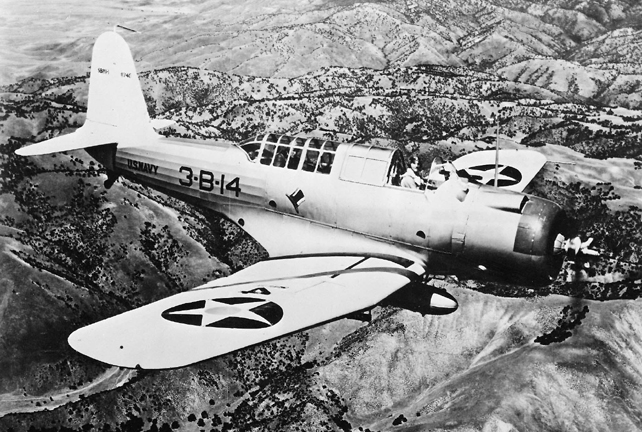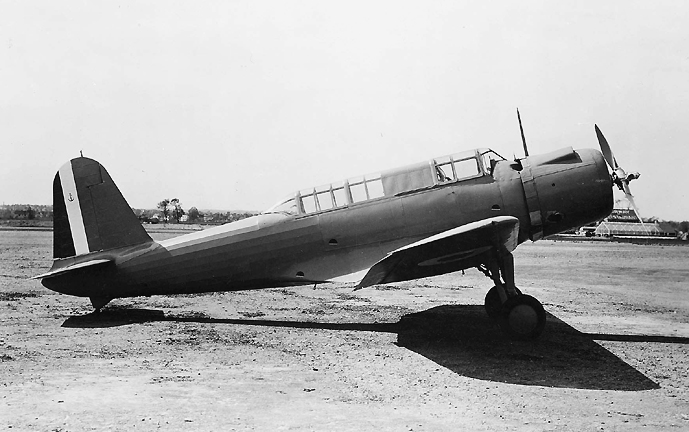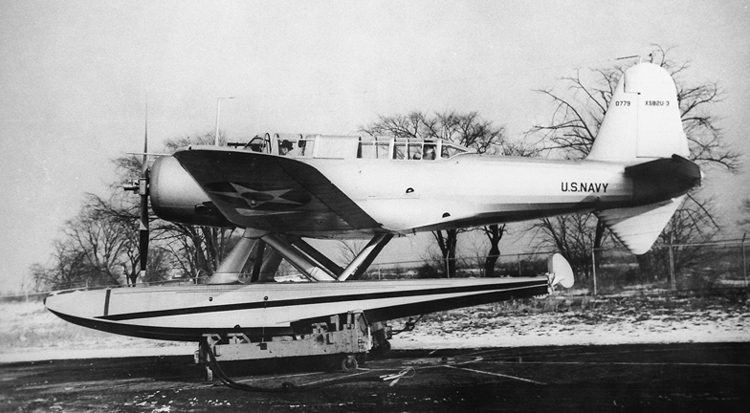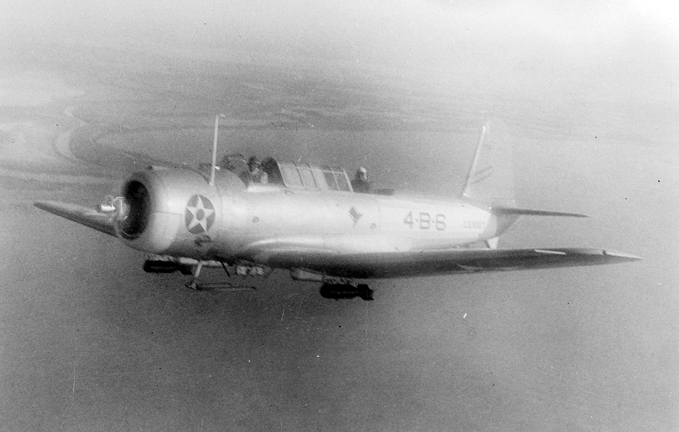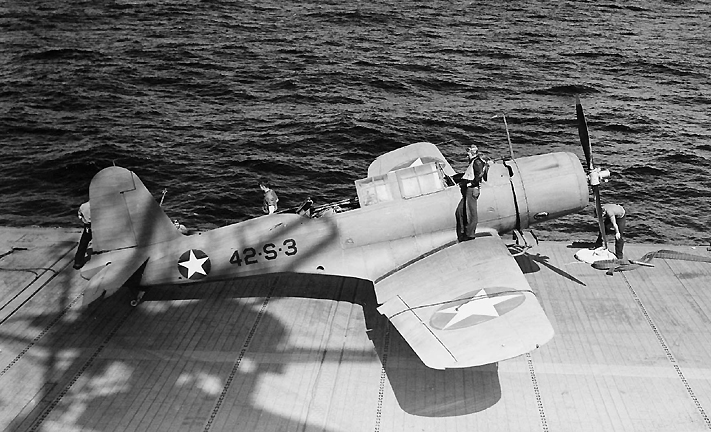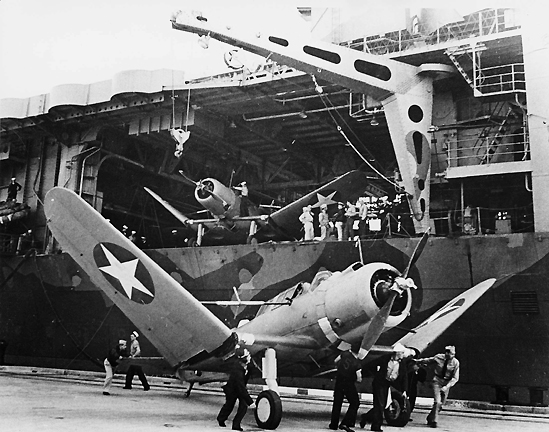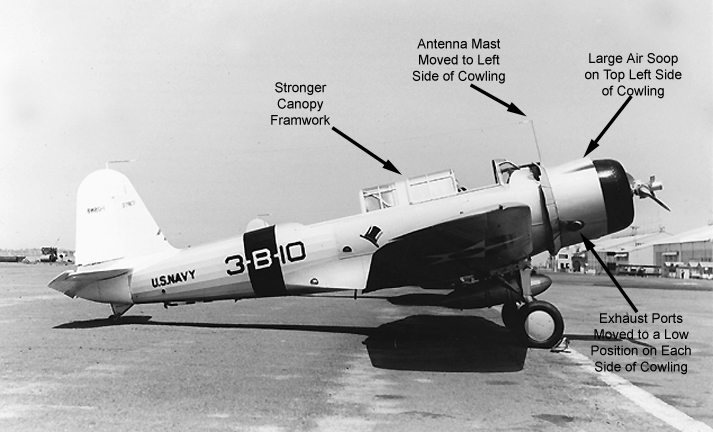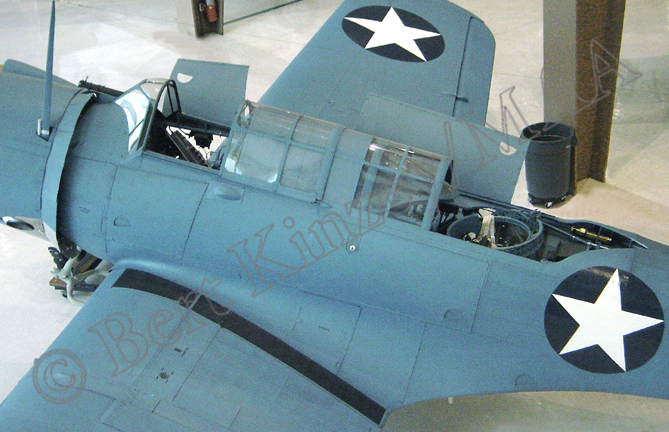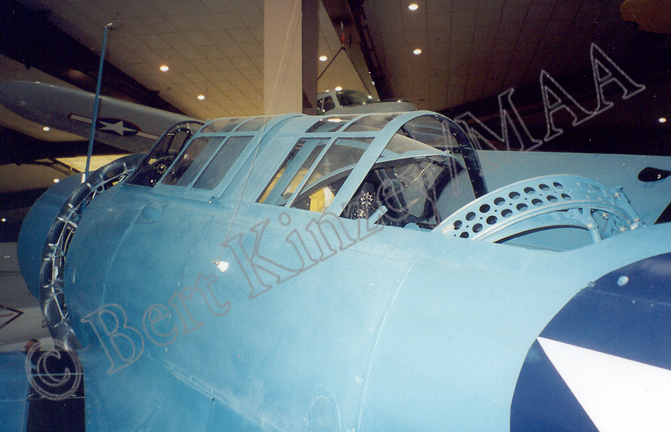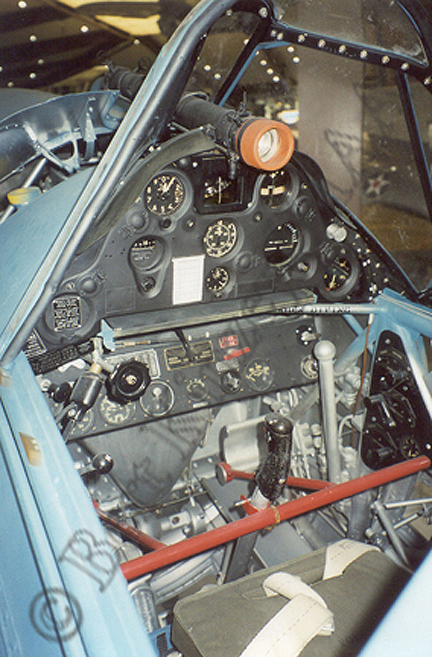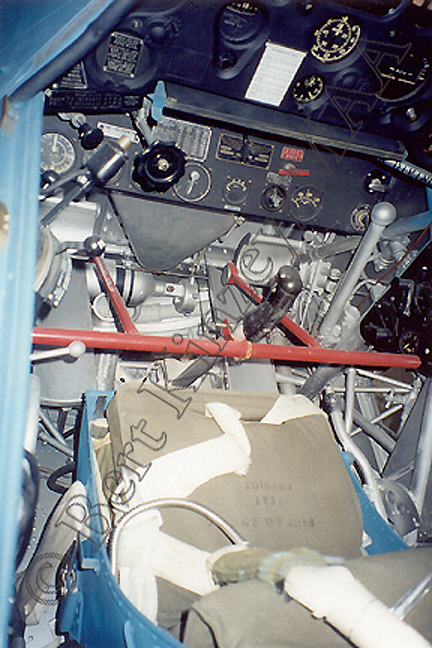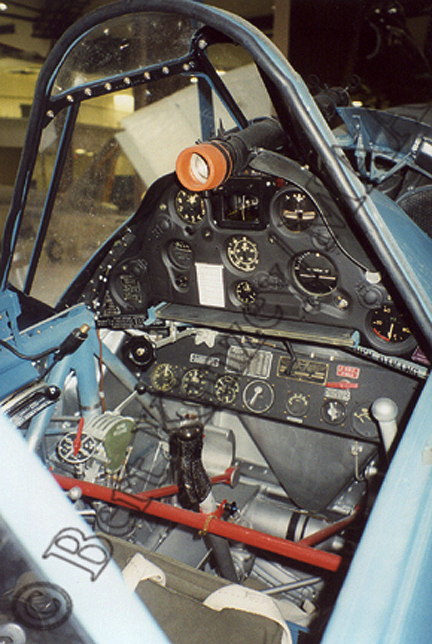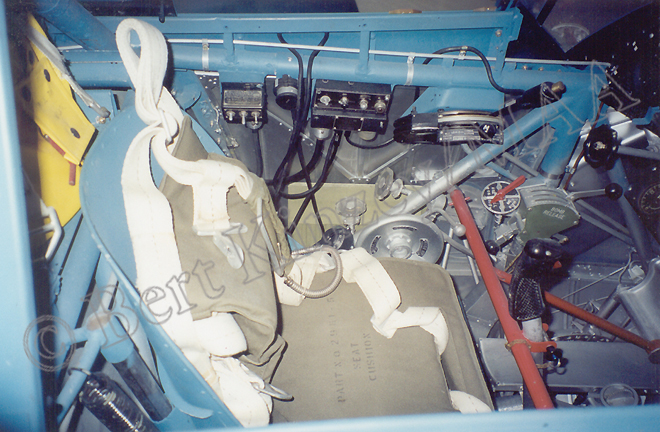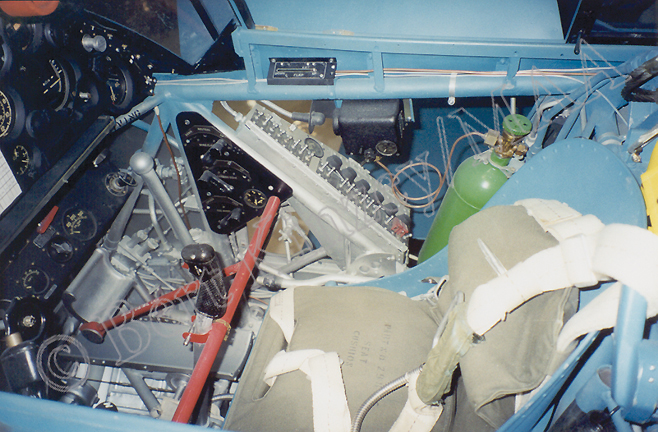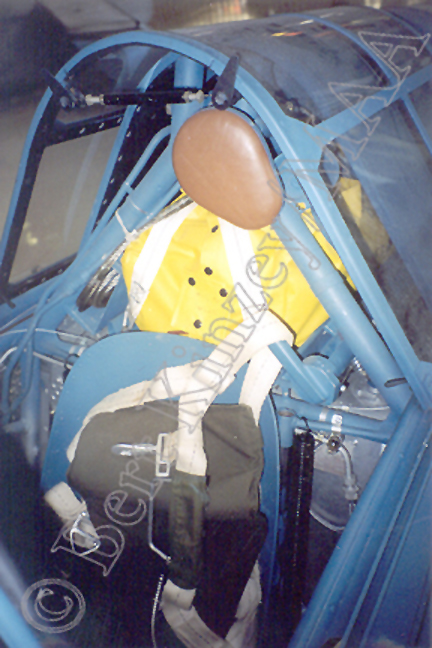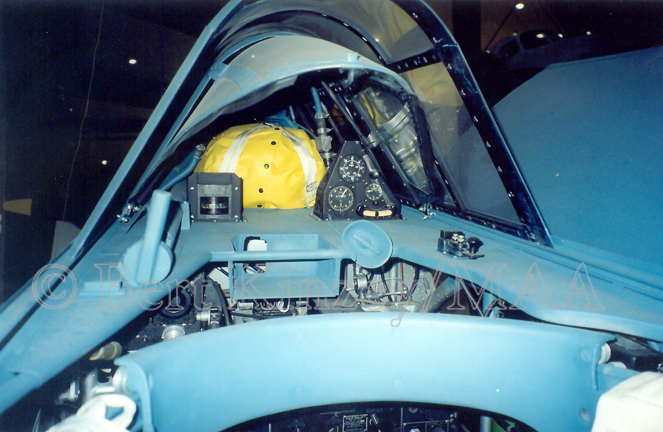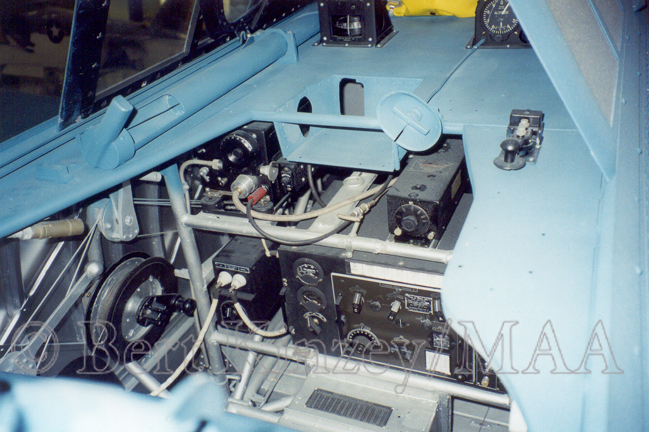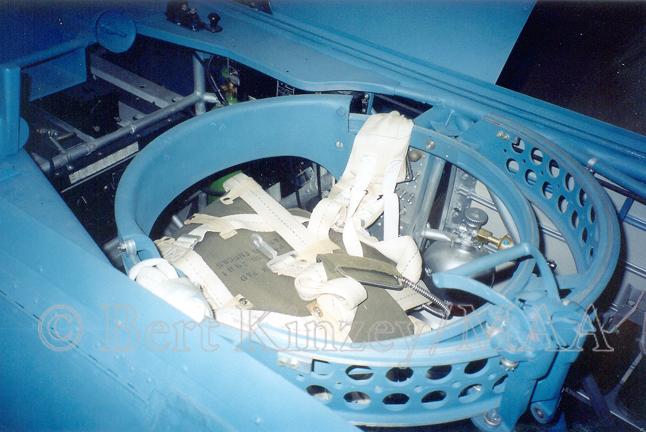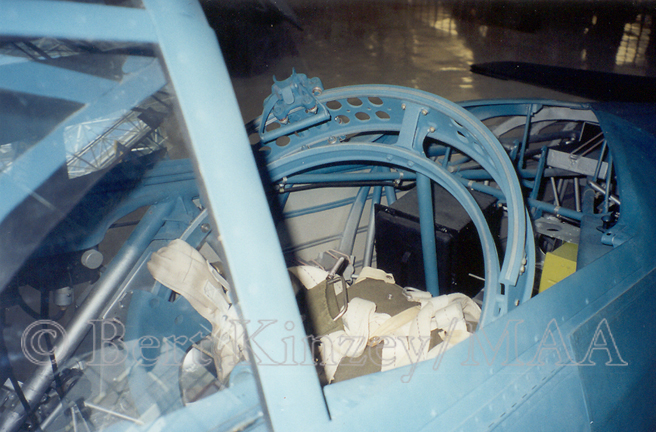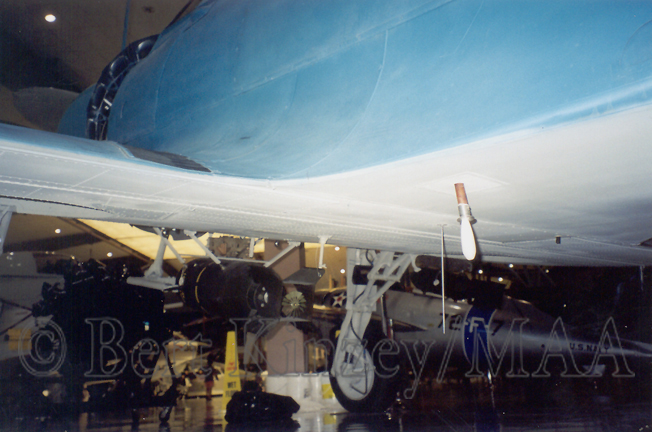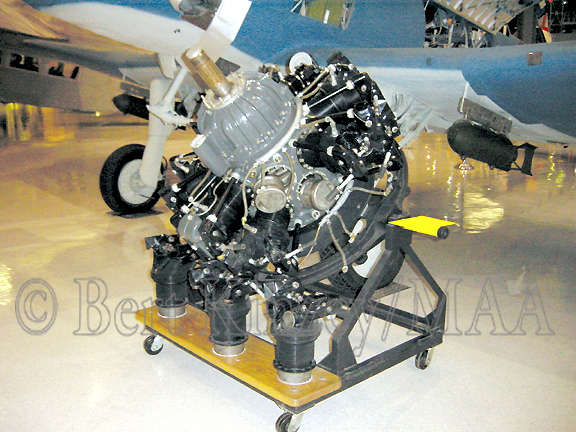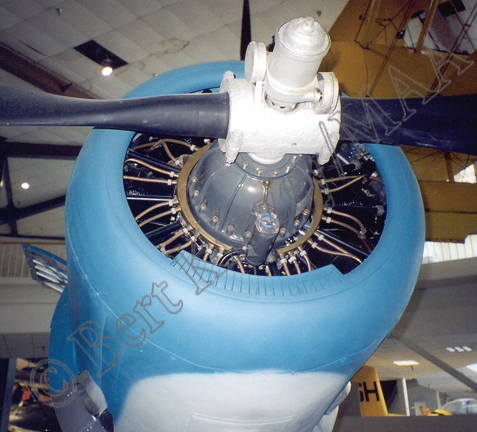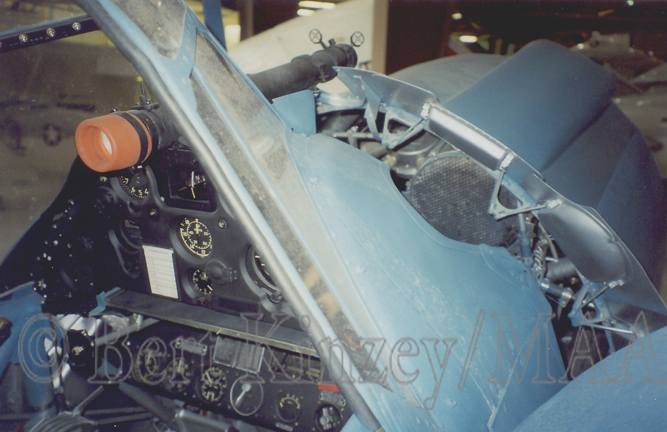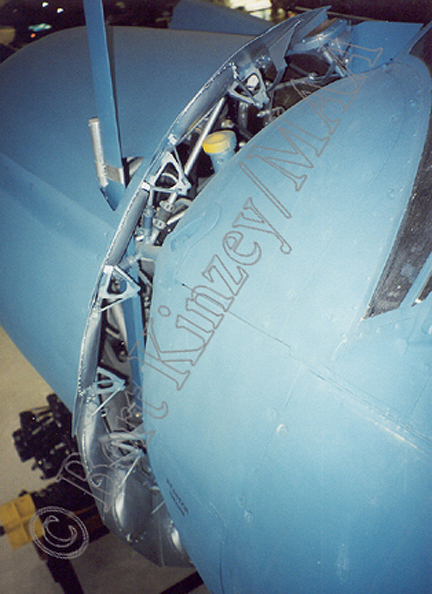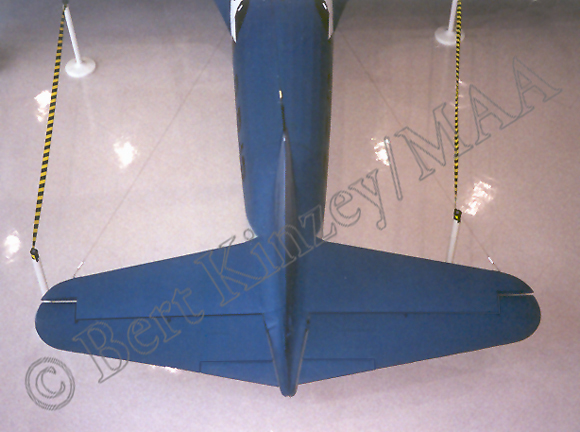Vought’s SB2U Vindicator was the U. S. Navy’s first monoplane scout-bomber and was second only to the TBD-1 Devastator as an operational carrier-based monoplane of any type for the Navy. It featured a long greenhouse canopy which covered the cockpits for the pilot and the radio operator/gunner, retractable landing gear, and a single Pratt & Whitney R-1535-78 radial engine that produced 700 horsepower at 8,900 feet. The outer wing panels were designed to fold upward for carrier storage. While much of its construction included a metal skin, there were still large areas of the aircraft that were covered by fabric. These included the aft fuselage, sections of the wings, and all control surfaces. An innovative design feature was that the ailerons could be lowered together to act as flaps to slow the speed for carrier landings.
The U. S. Navy ordered an XSB2U-1 prototype, BuNo. 9725, from Vought on October 11, 1934. But since there was considerable uncertainty concerning monoplanes at that time, an order for an XSB3U-1 biplane scout-bomber prototype was also placed four months later on February 7, 1935. The XSB2U-1 made its maiden flight on January 4, 1936, at Rentchler Field, Hartford, Connecticut, and additional manufacturer’s trials followed. The XSB2U-1 was then delivered to the Navy at Naval Air Station Anacostia on July 2, 1936. Comparative tests at Anacostia with both the XSB2U-1 and XSB3U-1 clearly validated the superiority of the monoplane configuration, so the XSB3U-1 biplane was canceled. Testing continued with the XSB2U-1 until it was lost in a crash that killed both crewmen on August 20, 1936, but the Navy was happy with the aircraft. After some modifications to the design, a contract was issued on October 26, 1936, for fifty-four SB2U-1 production aircraft at a cost of $2,240,995.
The first production SB2U-1 was completed in July 1937, and this aircraft continued the testing program in place of the prototype. Deliveries to the fleet began in December 1937 with VB-3 being the first squadron to receive the new aircraft. Once deliveries had been completed to VB-3, VB-2 became the second and last Navy squadron to receive the SB2U-1. Three SB2U-1s were retained for testing, and a few Navy and Marine squadrons received an SB2U-1 to be used in a utility role.
The SB2U-1 was very similar to the prototype. Differences included an upgrade to the R-1535-96 engine which produced 825 horsepower. This was a significant increase of 125 horsepower over the powerplant used in the XSB2U-1. It was fitted with a Hamilton Standard two-blade propeller which could be reversed in flight to slow speeds in a dive. The propeller had a diameter of 11 feet, 1 inch. This more powerful engine required a large oil cooler/carburetor air intake which was mounted on the upper starboard side of the cowling. A large scoop funneled air into the cooler/intake. The exhausts for the engine were moved from beneath the cowling to positions low on each side of it. Other small changes included relocating the antenna mast from the top of the cockpit enclosure to the port side of the cowling, just forward of the cooling flaps. The framework for the cockpit enclosure was strengthened as well.
The SB2U-1 could carry a 500 or 1,000-pound bomb on the centerline station beneath the aircraft. To insure the bomb cleared the arc of the propeller during a steep dive, bomb displacement gear, commonly called a trapeze, was installed to swing the bomb well clear of the aircraft when it was released. Alternatively, a 50-gallon fuel tank could be installed on the centerline station, and two 100-pound bombs or two depth charges could be carried on racks under the center wing sections. These racks were located outboard of the arc of the propeller, so no displacement gear was necessary.
A forward-firing .30-caliber machine gun was mounted in the right wing, and it was also outside the arc of the propeller, thus eliminating the need for any synchronization gear. Up to 500 rounds of ammunition could be carried for this gun. Provisions were made for a second fixed .30-caliber machine gun to be carried in the left wing, but this was seldom, if ever, fitted. A flexible .30-caliber machine gun was mounted on a ring in the rear cockpit and was used by the radio/operator as a defensive weapon to protect the aircraft. This gun was supplied with 600 rounds of ammunition.
An order for fifty-eight SB2U-2s was placed in January 1938, and these were entering squadron service by the end of that year. Only minor equipment changes differentiated the SB2U-2 from the SB2U-1. VB-4 aboard RANGER took delivery of early production SB2U-2s in December 1938. By the end of 1940, VB-2, VB-3, VB-4, VS-41, VS-42, VS-71 and VS-72 were all equipped with SB2U-1s or SB2U-2s.
One SB2U-1, BuNo. 0779, was converted to a floatplane and designated the XSB2U-3. The first production SB2U-3, BuNo. 2044, was also tested in the floatplane configuration as well, but a floatplane version was never put into production. Instead, BuNo. 2044 was converted back to the standard landplane configuration and all of the other fifty-seven SB2U-3s were also equipped with conventional landing gear.
The SB2U-3 was the first version to be called Vindicator, but the name was then applied to all aircraft in the series. The SB2U-3 was developed specifically for the Marine Corps, and it had an R-1535-02 engine which produced 825 horsepower. It also had a greater internal fuel capacity than the earlier versions to increase range. The .30-caliber machine guns of the SB2U-1 and SB2U-2 were replaced with .50-caliber weapons. Up to four .50-caliber machine guns could be installed in the wings, but typically only one was carried with an ammunition supply of 400 rounds. Several sources state that the flexible gun in the SB2U-3 was also a .50-caliber weapon, but the Standard Aircraft Characteristics for the SB2U-3, published on December 4, 1942, state that it remained the .30-caliber machine gun with 600 rounds of ammunition as found in the SB2U-1 and SB2U-2. The span of the SB2U-3’s horizontal tail was increased by almost two feet. All of these changes resulted in an empty weight that was 921 pounds heavier than that of the SB2U-2, and this degraded performance of the aircraft.
The first SB2U-3s were delivered in March 1941, and VMS-2 and VMS-1 soon received their first Vindicators. These units were later redesignated VMSB-231 and VMSB-131, respectively.
In the Atlantic, USS RANGER, CV-4, operated with her two squadrons of Vindicators, VS-41 and VS-42, during the months immediately following America’s entry into World War II. The two squadrons aboard USS WASP, VS-71 and VS-72, also flew routine patrol missions while that carrier operated in the Atlantic. WASP was transferred to the Pacific after transporting British aircraft to Malta, and her Vindicators were replaced with Dauntlesses. By the time RANGER participated in Operation Torch in November 1942, her SB2Us had also been replaced with SBDs.
The most notable use of the Vindicator in combat was at Midway when twenty-one SB2U-3s were reassigned from VMSB-231 to VMSB-241 to become part of the defending force on the island. On June 4, 1942, twelve of these aircraft took off from Midway to attack the Japanese fleet as part of a major strike consisting of Army and Marine aircraft. One Vindicator turned back because of mechanical problems, but the other eleven attacked the Japanese ships with 500-pound bombs. They scored no hits on the enemy and two of the SB2U-3s were lost. A third ran out of fuel and ditched on the way back to Midway, but the crew was rescued.
The following day, six SBD-2s and six SB2U-3s took off for a follow-up attack, but the target could not be found in the poor weather. While returning to Midway, one of the Vindicators suddenly plunged into the sea, and the crew was lost. On June 5, the remaining Dauntlesses and Vindicators participated in the attack on the cruisers MOGAMI and MIKUMA. Captain Richard E. Flemming’s SB2U-3 was hit by anti-aircraft fire and it crashed into MIKUMA’s aft turret. For his part in this action, Captain Flemming was awarded the Medal of Honor.
Three Vindicators remained on Midway until September 1943, but none were ever used again in combat. The last squadron to use the Vindicator in operational service was VB-9. This unit was equipped with SB2U-1s until February 28, 1943. Surviving Vindicators were used in training and utility roles after being withdrawn from operational service. A total of 170 SB2Us of all types was built for the U. S. Navy.
On February 22, 1939, the French placed an order for twenty aircraft which they designated the V-156-F. While similar to the SB2U-2, the French ordered several changes to be made. The bomb displacement gear was removed with the intention of replacing it with similar gear of a French production. However, this did not happen, and the French aircraft operated with only the hardpoints under the wings to carry bombs. The telescopic sight was removed, and French machine guns and radio gear replaced the equipment used in the American aircraft. The operation of the throttle was changed to the French design, which was opposite that in aircraft of other countries. Full power was obtained by pulling the throttle to the rear, while reducing power was achieved by pushing the throttle forward. The French also had fence type dive brakes installed on their aircraft. This feature had been tested and rejected by the U. S. Navy.
The initial order of twenty V-156-Fs was followed by a second order for twenty aircraft in May 1939. The French used their V-156-Fs in combat for several months with mixed success until August 1940.
A third order for fifty V-156-Fs was placed by France on March 1940. However, these were not ready for delivery until after France surrendered to Germany, so the order was taken over by the British. The British changed the designation to V-156-B1, and they named the aircraft Chesapeake. Several changes were made in order to make these aircraft acceptable to the British. These included changing the throttles back to the standard arrangement where power was increased by pushing it forward and pulling it aft to decrease power. The larger internal fuel tanks of the SB2U-3 were installed, and four fixed .30-caliber machine guns were installed in the wings. Armor protection was added for the crew and vital components, and the fence type dive brakes were deleted.
The long take-off roll of the V-156-B1 made it impossible to use on British escort carriers, so they all were used by land-based units. None were ever used in combat, all being relegated to utility roles instead.
Historical Photos:
This photo set includes photos of a historical nature that illustrate the development and service of the SB2U scout-bomber. They complement our Information File. All are U. S. Navy official photographs and were taken from the files of the National Museum of Naval Aviation.
DATA:
XSB2U-1
Number Built: 1
BuNo. 9725
Initial prototype
| Physical Data | |
|---|---|
|
Span
|
41 feet, 11 inches (extended) 16 feet, 0 inches (folded) |
|
Length
|
33 feet, 2 inches |
|
Height
|
15 feet, 10 inches (to top of radio mast) |
|
Wing Area
|
305.3 square feet |
|
Empty Weight
|
4,315 pounds |
|
Gross Weight
|
5,916 pounds |
|
Maximum Weight
|
6,191 pounds |
|
Powerplant
|
Pratt & Whitney R-1535-78 (750 hp @ 8,900 feet) |
|
Fuel
|
130 gallons (internal) |
| Performance Data | |
|---|---|
|
Top Speed
|
230 mph @ 8,900 feet |
|
Landing Speed
|
66 miles per hour |
|
Service Ceiling
|
26,600 feet |
|
Rate of Climb
|
5,000 feet in 3.7 minutes |
|
Range
|
892 miles |
SB2U-1
Number Built 54
BuNos. 0726-0778
| Physical Data | |
|---|---|
|
Span
|
41 feet, 11 inches (extended) 16 feet, 0 inches (folded) |
|
Length
|
33 feet, 2 inches |
|
Height
|
10 feet, 3 inches (on wheels) 14 feet, 2 inches (level) |
|
Wing Area
|
305.3 square feet |
|
Empty Weight
|
5,050 pounds |
|
Gross Weight
|
6,323 pounds |
|
Maximum Weight
|
7,972 pounds |
|
Powerplant
|
Pratt & Whitney R-1535-96 (825 hp at take off) |
|
Fuel
|
118 gallons (internal) 50-gallon drop tank (on centerline) |
| Performance Data | |
|---|---|
|
Top Speed
|
250 mph @ 9,500 feet |
|
Landing Speed
|
66 miles per hour |
|
Service Ceiling
|
27,400 feet |
|
Rate of Climb
|
1,500 per minute |
|
Range
|
1,004 miles in scouting configuration |
| Armament | |
|---|---|
|
Bombs:
|
1 X 500, 1,000 or 1,600 pound bomb or 1 X 350 pound depth charge |
|
Centerline
|
|
|
Wing
|
2 X 100-pound bombs or 2 X 350-pound depth charges |
|
Machine Guns
|
1 or 2 .30-caliber machine guns in wings with 400 rounds per gun and 1 .30-caliber flexible gun in rear cockpit with 600 rounds |
SB2U-2
Number Built 58
BuNos. 1326-1383
| Physical Data | |
|---|---|
|
Span
|
41 feet, 11 inches (extended) 16 feet, 0 inches (folded) |
|
Length
|
33 feet, 2 inches |
|
Height
|
10 feet, 3 inches (on wheels) 14 feet, 2 inches (level) |
|
Wing Area
|
305.3 square feet |
|
Empty Weight
|
4,713 pounds |
|
Gross Weight
|
6,379 pounds |
|
Maximum Weight
|
7,332 pounds |
|
Powerplant
|
Pratt & Whitney R-1535-96 (825 hp at take off) |
|
Fuel
|
118 gallons (internal) 50-gallon drop tank (on centerline) |
| Performance Data | |
|---|---|
|
Top Speed
|
250 mph @ 9,500 feet |
|
Landing Speed
|
66 miles per hour |
|
Service Ceiling
|
27,400 feet |
|
Rate of Climb
|
1,500 per minute |
|
Range
|
1,004 miles in scouting configuration |
| Armament | |
|---|---|
|
Bombs:
|
1 X 500, 1,000 or 1,600 pound bomb or 1 X 350 pound depth charge |
|
Centerline
|
|
|
Wing
|
2 X 100-pound bombs or 2 X 350-pound depth charges |
|
Machine Guns
|
1 or 2 .30-caliber machine guns in wings with 400 rounds per gun and 1 .30-caliber flexible gun in rear cockpit with 600 rounds |
SB2U-3
Number Built 57
BuNos. 2044-2100
| Physical Data | |
|---|---|
|
Span
|
41 feet, 11 inches (extended) 16 feet, 0 inches (folded) |
|
Length
|
33 feet, 2 inches |
|
Height
|
10 feet, 3 inches (on wheels) 14 feet, 2 inches (level) |
|
Wing Area
|
305.3 square feet |
|
Empty Weight
|
5,634 pounds |
|
Gross Weight
|
7,474 pounds |
|
Maximum Weight
|
9,421 pounds |
|
Powerplant
|
Pratt & Whitney R-1535-02 (825 hp at take off) |
|
Fuel
|
464 gallons (internal only, no provision for external fuel) |
| Performance Data | |
|---|---|
|
Top Speed
|
243 mph @ 9,500 feet |
|
Landing Speed
|
71 miles per hour |
|
Service Ceiling
|
23,600 feet |
|
Rate of Climb
|
1,070 per minute |
|
Range
|
2,450 miles ferry |
| Armament | |
|---|---|
|
Bombs:
|
1 X 500, 1,000 or 1,600 pound bomb or 1 X 350 pound depth charge |
|
Centerline
|
|
|
Wing
|
2 X 100-pound bombs or 2 X 350-pound depth charges |
|
Machine Guns
|
Up to four .50-caliber machine guns in wings with 400 rounds per gun and one .30-caliber flexible gun in rear cockpit with 600 rounds |

